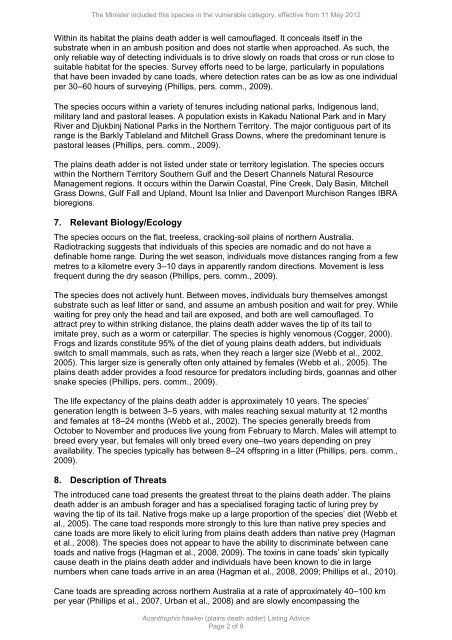Plains Death Adder - Department of the Environment, Water ...
Plains Death Adder - Department of the Environment, Water ...
Plains Death Adder - Department of the Environment, Water ...
You also want an ePaper? Increase the reach of your titles
YUMPU automatically turns print PDFs into web optimized ePapers that Google loves.
The Minister included this species in <strong>the</strong> vulnerable category, effective from 11 May 2012<br />
Within its habitat <strong>the</strong> plains death adder is well camouflaged. It conceals itself in <strong>the</strong><br />
substrate when in an ambush position and does not startle when approached. As such, <strong>the</strong><br />
only reliable way <strong>of</strong> detecting individuals is to drive slowly on roads that cross or run close to<br />
suitable habitat for <strong>the</strong> species. Survey efforts need to be large, particularly in populations<br />
that have been invaded by cane toads, where detection rates can be as low as one individual<br />
per 30–60 hours <strong>of</strong> surveying (Phillips, pers. comm., 2009).<br />
The species occurs within a variety <strong>of</strong> tenures including national parks, Indigenous land,<br />
military land and pastoral leases. A population exists in Kakadu National Park and in Mary<br />
River and Djukbinj National Parks in <strong>the</strong> Nor<strong>the</strong>rn Territory. The major contiguous part <strong>of</strong> its<br />
range is <strong>the</strong> Barkly Tableland and Mitchell Grass Downs, where <strong>the</strong> predominant tenure is<br />
pastoral leases (Phillips, pers. comm., 2009).<br />
The plains death adder is not listed under state or territory legislation. The species occurs<br />
within <strong>the</strong> Nor<strong>the</strong>rn Territory Sou<strong>the</strong>rn Gulf and <strong>the</strong> Desert Channels Natural Resource<br />
Management regions. It occurs within <strong>the</strong> Darwin Coastal, Pine Creek, Daly Basin, Mitchell<br />
Grass Downs, Gulf Fall and Upland, Mount Isa Inlier and Davenport Murchison Ranges IBRA<br />
bioregions.<br />
7. Relevant Biology/Ecology<br />
The species occurs on <strong>the</strong> flat, treeless, cracking-soil plains <strong>of</strong> nor<strong>the</strong>rn Australia.<br />
Radiotracking suggests that individuals <strong>of</strong> this species are nomadic and do not have a<br />
definable home range. During <strong>the</strong> wet season, individuals move distances ranging from a few<br />
metres to a kilometre every 3–10 days in apparently random directions. Movement is less<br />
frequent during <strong>the</strong> dry season (Phillips, pers. comm., 2009).<br />
The species does not actively hunt. Between moves, individuals bury <strong>the</strong>mselves amongst<br />
substrate such as leaf litter or sand, and assume an ambush position and wait for prey. While<br />
waiting for prey only <strong>the</strong> head and tail are exposed, and both are well camouflaged. To<br />
attract prey to within striking distance, <strong>the</strong> plains death adder waves <strong>the</strong> tip <strong>of</strong> its tail to<br />
imitate prey, such as a worm or caterpillar. The species is highly venomous (Cogger, 2000).<br />
Frogs and lizards constitute 95% <strong>of</strong> <strong>the</strong> diet <strong>of</strong> young plains death adders, but individuals<br />
switch to small mammals, such as rats, when <strong>the</strong>y reach a larger size (Webb et al., 2002,<br />
2005). This larger size is generally <strong>of</strong>ten only attained by females (Webb et al., 2005). The<br />
plains death adder provides a food resource for predators including birds, goannas and o<strong>the</strong>r<br />
snake species (Phillips, pers. comm., 2009).<br />
The life expectancy <strong>of</strong> <strong>the</strong> plains death adder is approximately 10 years. The species’<br />
generation length is between 3–5 years, with males reaching sexual maturity at 12 months<br />
and females at 18–24 months (Webb et al., 2002). The species generally breeds from<br />
October to November and produces live young from February to March. Males will attempt to<br />
breed every year, but females will only breed every one–two years depending on prey<br />
availability. The species typically has between 8–24 <strong>of</strong>fspring in a litter (Phillips, pers. comm.,<br />
2009).<br />
8. Description <strong>of</strong> Threats<br />
The introduced cane toad presents <strong>the</strong> greatest threat to <strong>the</strong> plains death adder. The plains<br />
death adder is an ambush forager and has a specialised foraging tactic <strong>of</strong> luring prey by<br />
waving <strong>the</strong> tip <strong>of</strong> its tail. Native frogs make up a large proportion <strong>of</strong> <strong>the</strong> species’ diet (Webb et<br />
al., 2005). The cane toad responds more strongly to this lure than native prey species and<br />
cane toads are more likely to elicit luring from plains death adders than native prey (Hagman<br />
et al., 2008). The species does not appear to have <strong>the</strong> ability to discriminate between cane<br />
toads and native frogs (Hagman et al., 2008, 2009). The toxins in cane toads’ skin typically<br />
cause death in <strong>the</strong> plains death adder and individuals have been known to die in large<br />
numbers when cane toads arrive in an area (Hagman et al., 2008, 2009; Phillips et al., 2010).<br />
Cane toads are spreading across nor<strong>the</strong>rn Australia at a rate <strong>of</strong> approximately 40–100 km<br />
per year (Phillips et al., 2007, Urban et al., 2008) and are slowly encompassing <strong>the</strong><br />
Acanthophis hawkei (plains death adder) Listing Advice<br />
Page 2 <strong>of</strong> 8















